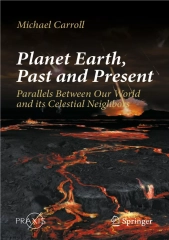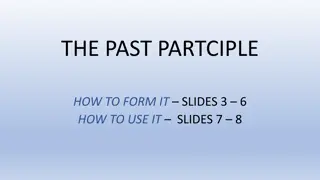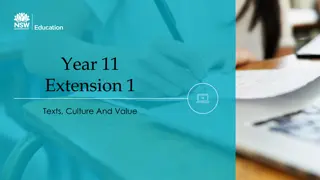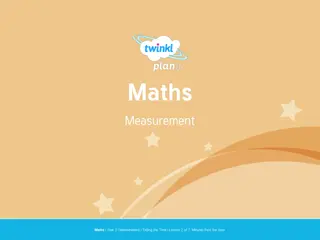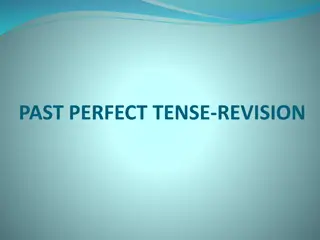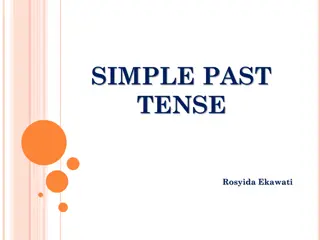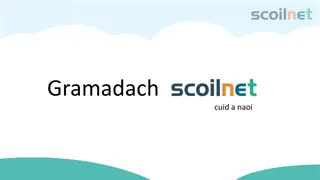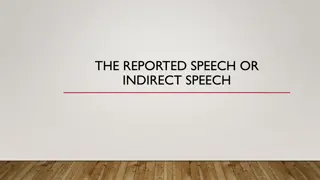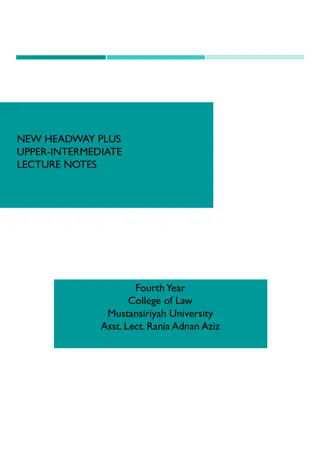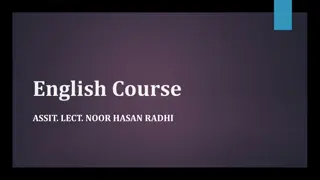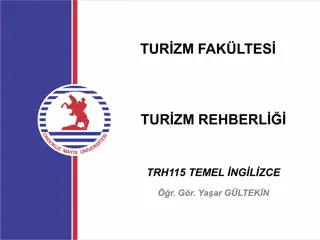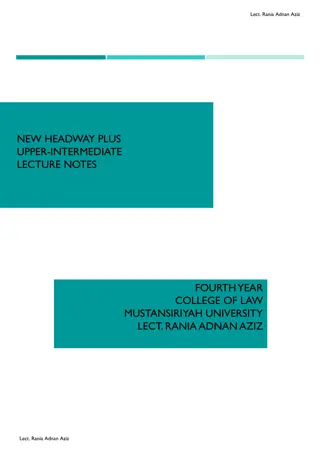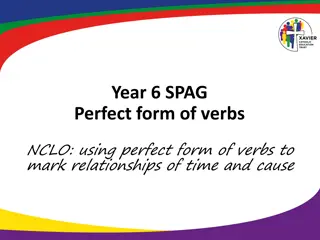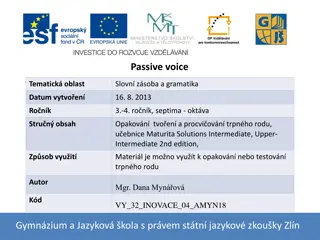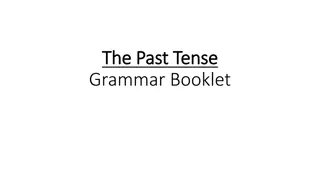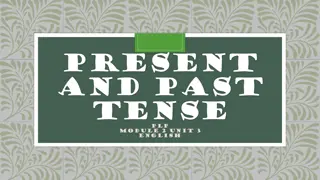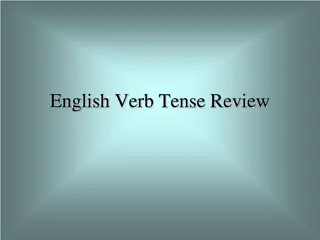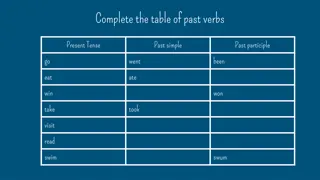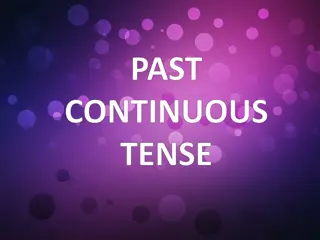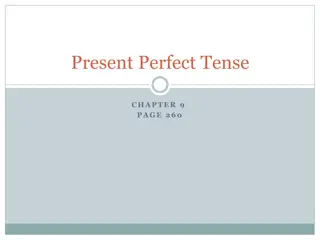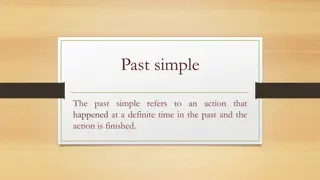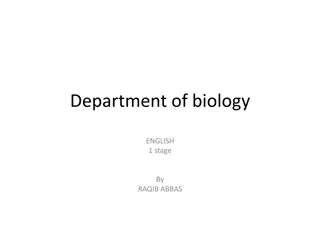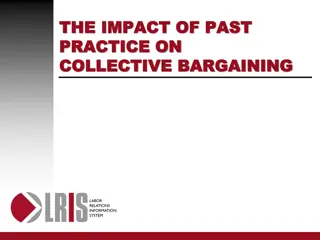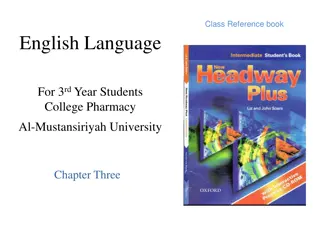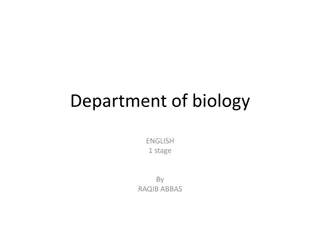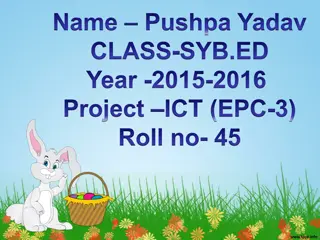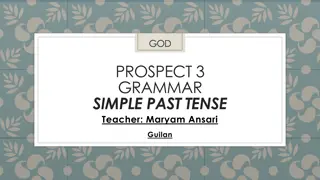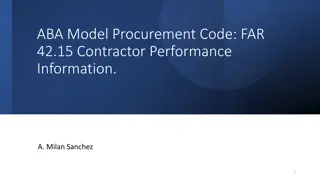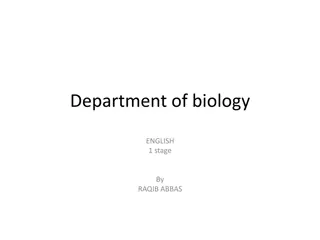PDF_⚡ Planet Earth, Past and Present: Parallels Between Our World and its Celest
\"COPY LINK HERE ; https:\/\/getpdf.readbooks.link\/3031413598\n\nget [PDF] Download Planet Earth, Past and Present: Parallels Between Our World and its Celestial Neighbors (Springer Praxis Books) | Planet Earth, Past and Present: Parallels Between Our World and its Celestial Neighbors (Springer Pra
0 views • 6 slides
Learn Past Continuous Tense - Grade 6 English Lesson
This Grade 6 English lesson focuses on understanding and correctly using the past continuous tense. It covers the rules for forming the past continuous tense, examples of its usage, and an assessment to test comprehension. Students will practice talking about actions happening at specific times in t
4 views • 6 slides
Understanding Present vs. Past Tenses in English Grammar
Exploring the basics of present and past tenses in English grammar, covering affirmative, negative, and interrogative structures, as well as adverbs of frequency and quantity. Learn about describing general facts, habitual actions, and specific past events through detailed examples and visual aids.
8 views • 13 slides
Learning Past Continuous Tense with Pronouns and Forming Questions
Explore how to use pronouns with "was" and "were" in the past continuous tense through examples and practice sentences. Learn to form questions using the past continuous tense and develop an understanding of when to use "was" or "were" with different subjects. Improve your grammar skills with this l
9 views • 15 slides
Mastering the Past Participle in English Verbs
Understand how to form and use the past participle in English verbs, both regular and irregular. Learn the rules for forming regular past participles, including when to double consonants and when to change 'y' to 'i'. Discover examples of irregular verbs and how their past participles are formed. Ex
0 views • 8 slides
Understanding Past Tenses in Narratives
Exploring the use of past simple, past continuous, past perfect, and past perfect continuous tenses in narratives with examples and explanations. Learn how to convey different past events and their relationships in storytelling.
1 views • 4 slides
Exploring Texts, Culture, and Value Through Appropriation
In Year 11 Extension 1, students delve into texts from the past and their influence on present culture. They analyze the relationships between texts and culture, language's impact on values, and different responses to texts. Through close study, they explore key texts from the past, examining how th
0 views • 9 slides
Mastering Time: Learn to Tell Exact Time with Precision
Explore the art of telling time with precision, understanding minutes past the hour, clock intervals, and concepts like quarter past, half past, and quarter to. Enhance your skills through quizzes and practical examples, and discover how counting on and counting back can help you find the exact time
1 views • 14 slides
Learning to Tell Time in Minutes: Minutes Past the Hour
Explore how to tell the time in minutes past the hour by counting clockwise in intervals of five and then adding single minutes to find the exact time. Practice identifying time expressions like "quarter past" and "half past" as well as reading the time to the nearest minute.
0 views • 24 slides
Mastering the Past Perfect Tense: A Comprehensive Guide
Explore the intricacies of the past perfect tense through engaging examples of two different events at different times in the past, understanding how to form sentences correctly and use time expressions effectively. Dive into exercises to enhance your grasp of the past perfect tense.
0 views • 10 slides
Understanding Historical Research: Methods, Purposes, and Aims
Historical research involves investigating past events systematically to provide a dynamic explanation, interpretation, and understanding of the past. It aims to uncover unknown aspects, answer unexplored questions, and link past happenings to the present to enrich human culture and encourage interd
0 views • 20 slides
Understanding Simple Past Tense in English Grammar
Explore the usage of simple past tense through examples, irregular verbs, and regular verb forms. Learn how to form affirmative, negative, and question sentences in the past. Enhance your understanding of past actions and events with clear explanations and practice exercises.
1 views • 19 slides
Understanding Irish Grammar: Past Tense Verbs and Questions
Delve into the intricacies of forming past tense verbs and asking questions in Irish grammar. Learn the rules for changing broad and slender verbs, both one and two syllables long. Discover how to form questions and negatives in the past tense, along with a quick recap of key points for easy referen
3 views • 5 slides
Mastering Reported Speech: Simple Present to Simple Past
Learn how to convert statements from the simple present tense to the simple past tense in reported speech with clear examples. Practice exercises are provided for better understanding, covering various sentence structures including negative sentences and present continuous to past continuous transfo
0 views • 45 slides
Understanding Regular and Irregular Verbs in Simple Past Tense
Learn how to form the simple past tense with regular and irregular verbs. Regular verbs end in "-ed," while irregular verbs have unique past tense forms. Examples and images illustrate the differences, helping you master past tense verb usage effortlessly.
0 views • 11 slides
Understanding the Present Perfect Tense in English Grammar
The lecture notes explore the Present Perfect tense, highlighting its connection between past actions and their relevance in the present. It compares the Past and Present Perfect tenses, discussing the nuanced differences and providing examples for clarity. The document covers the usage of the Prese
0 views • 8 slides
Understanding the Past Perfect Tense in English Grammar
The Past Perfect Tense is used to talk about actions completed before a certain point in the past, emphasizing the sequence of events. This tense follows the structure of "had + past participle" and is crucial for expressing events that happened earlier than others in a narrative. Knowing how to for
0 views • 27 slides
Understanding Simple Past Tense and Passive Voice Formation
The provided content covers the usage of simple past tense to discuss past events and the formation of passive voice in English grammar. Examples and explanations are given, along with vocabulary exercises and an apology scenario. Learn about making past verbs negative, forming passive sentences, an
0 views • 5 slides
Understanding Simple Past Tense in English: Rules and Examples
The simple past tense is a fundamental form in Modern English used to describe past events. It involves regular verbs adding "-ed" and irregular verbs having different forms. The construction of the simple past helps distinguish it from other past tense forms like past perfect and past progressive.
0 views • 33 slides
Understanding Narrative Tenses: Past Simple, Present Perfect, and Past Continuous
Explore the nuances of narrative tenses through detailed lecture notes by Lecturer Rania Adnan Aziz. Learn the differences between Past Simple and Present Perfect, grasp the usage of Past Continuous, and understand the significance of Past Perfect in expressing past actions and timelines. Dive into
0 views • 6 slides
Understanding the Past Perfect Tense in English Grammar
The past perfect tense expresses actions that occurred before another action in the past, referring to time up to a point in the past. It is often used in reported speech and formal writing to indicate completed actions before a specific event. The past perfect progressive tense emphasizes the durat
0 views • 15 slides
Understanding Principal Parts of Regular Verbs and Practice Exercises
Explore the principal parts of regular verbs including present, present participle, past, and past participle forms. Understand how regular verbs form their past and past participle, practice exercises to identify verb forms in sentences, and learn about verb conjugation rules.
0 views • 6 slides
Understanding Verb Tenses: Present Perfect and Past Perfect Forms
Explore the usage of present perfect and past perfect verb forms to indicate relationships of time and cause. Present perfect verbs denote actions with undefined past timing but relevance to the present, while past perfect verbs describe events that occurred before another past event. Examples and e
0 views • 7 slides
Understanding English Tenses: Present, Past, and Future
Understanding tenses in English grammar is essential for effective communication. Tenses indicate the time of an action or event, such as present, past, or future. This article explores the different types of tenses, including present tense, past tense, and future tense, along with examples to help
0 views • 22 slides
Understanding Passive Voice: Rules and Examples
Passive voice is a grammatical construction used when the focus is on the action itself rather than the doer. It is formed by combining a form of "to be" with the past participle of a verb. This content explores the usage of passive voice in different tenses - present simple, present continuous, pas
0 views • 14 slides
Mastering the Past Tense: A Comprehensive Grammar Guide
Dive into the intricacies of forming the past tense in English with this detailed booklet. Learn the rules for regular verb conjugation, explore examples, and practice with engaging exercises. Sharpen your language skills and gain confidence in using the past tense accurately.
0 views • 10 slides
Understanding Present and Past Tense in English
Explore the differences between present and past tense in English through examples and explanations. Learn to distinguish these tenses, use idioms in conversation, and enhance your vocabulary. Practice exercises to reinforce your understanding. Discover the significance of past tense forms and how t
0 views • 9 slides
English Verb Tense Review: Simple Present and Simple Past
Simple Present Tense is used for habitual actions, unchanging truths, and general statements of fact. It is indicated by words like always, usually, and sometimes. Simple Past Tense is used for completed actions and past habits indicated by words such as yesterday and last night. The forms and indic
0 views • 46 slides
Learning Past Verbs and Present Perfect Tense
This content discusses past tense verbs through completing tables, giving examples, and exploring the present perfect simple tense with real-world scenarios. It covers verb conjugations in the past tense, such as went, ate, won, took, and swam, along with explanations and exercises related to the pr
1 views • 14 slides
Understanding the Past Continuous Tense
The Past Continuous Tense is used to describe interrupted activities that continued for a period in the past or things happening continuously in the past. Learn how to form affirmative, interrogative, and negative sentences in this tense with examples and images.
0 views • 12 slides
Understanding the Present Perfect Tense - Chapter 9
The present perfect tense is used for actions or situations that occurred at an unspecified time in the past, repeated actions at unspecified times, ongoing actions from the past to the present, and more. Time expressions like "for" and "since" are essential in specifying durations and starting poin
0 views • 7 slides
Understanding the Past Simple Tense in English Grammar
The past simple tense refers to actions that occurred at a specific time in the past and are now completed. This tense follows a specific rule where the subject is combined with a verb (regular or irregular) and a complement. Adverbs like "yesterday," "ago," and "last" are commonly used with past si
0 views • 9 slides
Understanding Past Simple Tense in English Grammar
The past simple tense is used to describe completed actions or events that happened at a specific time in the past. Regular verbs form the past simple by adding "-ed", while irregular verbs have unique past tense forms. The structure for negative and question forms involves the auxiliary verb "did".
0 views • 6 slides
Understanding the Impact of Past Practices on Collective Bargaining
Exploring the significance of past practices in interpreting, supplementing, and potentially contradicting contract language within the context of collective bargaining. Covering topics such as the definition of past practices, the duty to bargain, waivers of protest rights, and remedies for unlawfu
0 views • 35 slides
Understanding Past Tenses in English for 3rd Year College Pharmacy Students
Dive into the intricacies of past tenses in English as you explore the nuances between past simple, past continuous, past perfect, and more. Test your grammar skills while learning to express events that occurred in the past, with a focus on practical application for students at Al-Mustansiriyah Uni
0 views • 25 slides
Understanding Past Perfect Tense in English Grammar
Past Perfect Tense is used to denote actions that were completed before another action occurred in the past. It is formed using the auxiliary verb "had" followed by a past participle. Examples of affirmative, negative, and question forms are provided to illustrate usage. The tense helps in sequencin
0 views • 4 slides
Common Regular Verbs and Their Past Tenses
Common regular verbs and their past tenses are essential aspects of grammar learning. Past tense forms of verbs are used to indicate actions or states that have already occurred. Examples of regular verbs and their corresponding past tenses are provided in this content, along with spelling rules for
0 views • 17 slides
Understanding Simple Past Tense in Grammar
In this file, we delve into the concept of simple past tense in grammar. Through examples and explanations, you will learn how to use the simple past tense to talk about completed actions in the past. The structure, usage, and importance of simple past tense are covered extensively to enhance your u
0 views • 30 slides
Enhancing Federal Procurement Standards Through Past Performance Documentation
Proposal to add a FAR Subpart 42.15-like section to the MPC for recording Contractor Performance Information, in alignment with OMB guidance in 2 CFR Part 200. The history and importance of past performance evaluation in federal grants and agreements are highlighted, emphasizing the need for a struc
0 views • 13 slides
Understanding the Past Continuous Tense in English Grammar
Past Continuous Tense is used to describe ongoing actions in the past. It is formed with "was/were" + present participle (-ing). Learn its structure, usage, negation, and questioning forms with examples. Enhance your English grammar skills by mastering the Past Continuous Tense.
0 views • 4 slides
